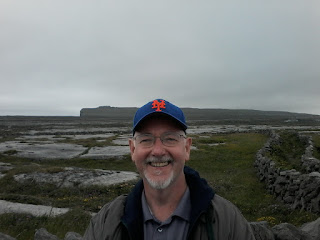Dear Folks,
And a happy Sabbath to everyone! It's been three weeks since I've posted anything. I talked to my sister Liz on the phone once or twice and also to the cousins here in Ireland once or twice, but I've really been out of contact with everyone the whole time.
That's a picture above I took on Inis Mor, the largest of the Aran Islands. I spent a day out there walking around during my last week out west before coming to Dublin to start work. The Aran Islands are three islands in Galway Bay, the terrain is extremely rocky. The islands are composed of limestone with at most 10 inches of topsoil. The Islanders had the tradition of 'making the land', they would break up the rock and wall in a small field. They would carry up seaweed and sand from the beaches and cover the ground with altering layers before covering it all with a small amount of topsoil that they may have ferried over. They would grow rye for the seed and for the straw which was used as thatch and to make rope and other objects, and potatoes. They also raised sheep and cattle.
There are no rivers or underground streams or sources of well water on the islands. The Islanders had to catch rainwater in cisterns made of rock, like the one below.
It's an unbelievably harsh landscape, it amazes me that people would have chosen to live on the islands in the first place. There are only about 1,200 living on the islands now a days, but the population was larger in earlier times. During the Cromwellian conquests in the 17th centuries, Catholics living in Ulster were displaced to Connacht (they were given a choice of Connacht or hell), and some made their homes on the islands of the west coast where they developed a system of self sufficiency.
There is a bronze age 'ring fort' called Dun Aengus on Inis Mor. It sits on the edge of a steep cliff. I was walking the island and so did not make it all the way to Dun Aengus this time. There it is in the background behind me. My nephew Christopher and I visited there last September.
Dun Aengus sits high on a cliff, it's a dramatic view. They call it a fort, but archaeologists are unsure why it was really built. It could have been a kind of a lighthouse or a place of sacrifice for the druids. They are also not sure how old it is, though some have suggested it dates from the second century B.C.E.
I lost my blue and orange Mets cap on Inis Mor or on the ferry. I'm a little disappointed about that. I have my grey one still, but I would like the home colors. I don't think you can find a Mets cap anywhere in Ireland, just Yankees and Red Sox.
I'll probably be posting later today to catch family and friends up about what I've been doing over the last few weeks. Right now I'm going to get ready to attend Sabbath services with the Living Church of God congregation in Dublin. Take care,
Luke





